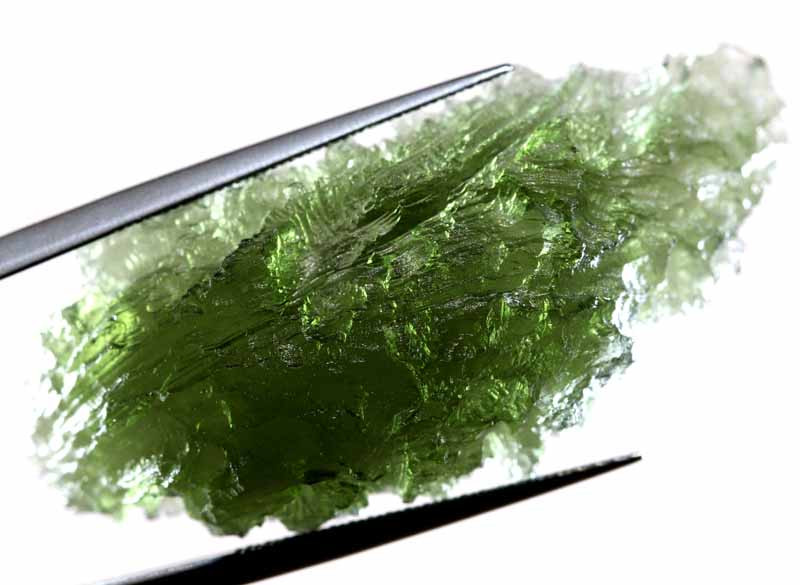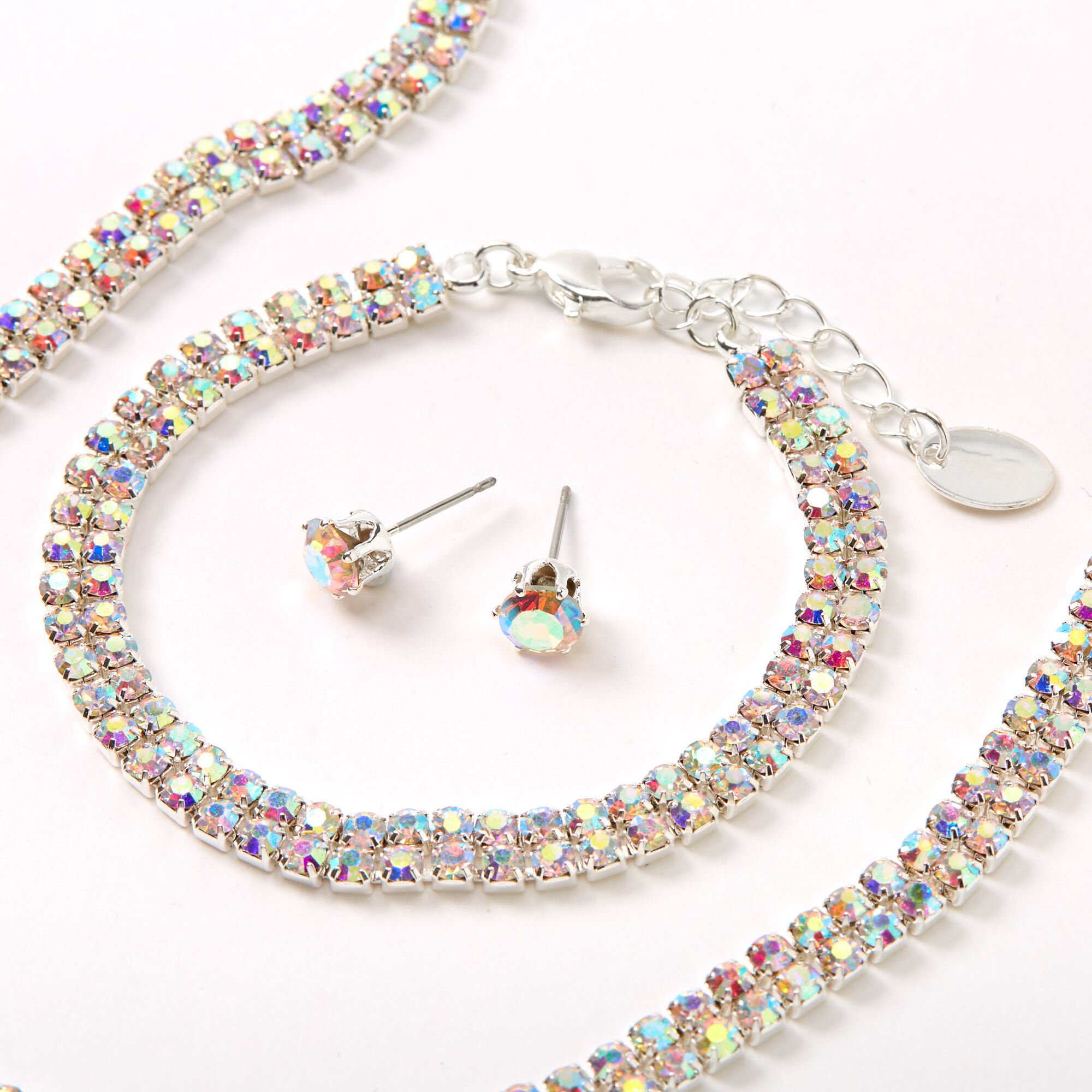
Glass Gemstone: Properties, Meanings, Value & More
 Glass is often used as an alternative to crystal gemstones, though some natural gems are actually glass.
Glass is often used as an alternative to crystal gemstones, though some natural gems are actually glass.
Wait, is glass a gemstone? What qualifies something as a “gemstone” is often debated. Since glass is used similarly to crystals, we’d say glass can be a gemstone.
Some may see glass gemstones as “fake,” but adorning oneself in beautiful glass goes back centuries.
Today, we’ll explore the types of glass gemstones — both natural and synthetic — along with the history, price, and benefits of glass gemstones.

What Is A Glass Gemstone?
Glass gemstones can be considered semi-precious gems.
These can imitate famous crystals, making glass gemstones affordable alternatives for many birthstones or zodiac stones.
Plus, glass is the traditional 3rd wedding anniversary gift.
Glass Specifications & Characteristics
By definition, glass is an amorphous solid with a rigid but random atomic structure.
“Amorphous” means glass isn’t a crystal, like opal. What are glass gems made of? The composition is variable, but glass is almost always predominantly silica.
You may know quartz is made of silica, so what is glass vs quartz? Quartz is a mineral with a set crystal structure, while glass is a mineraloid with a random molecular structure.
Around 90 percent of glass used today is made of silica, sodium carbonate (soda), and calcium carbonate (limestone) — so, it’s called “soda-lime-silica” glass.
The majority of glass today is man-made with a 5 to 5.5 Mohs hardness scale ranking. Around 90 percent of man-made glass contains about 70 percent silica.
Glass properties listed:
Mohs hardness: 4.5-7
Color: Commonly green to blue-green (natural); Virtually any color, including colorless, multi-color, and bi-color (synthetic)
Crystal structure: None
Luster: Vitreous
Transparency: Transparent to opaque
Refractive index: 1.47-1.70 (can be higher than 1.81, varies by composition)
Density: 2.3-4.5
Cleavage: None
Fracture: Conchoidal, granular, or splintery
Streak: White
Luminescence: Variable
Pleochroism: None
Dispersion: 0.009-0.098 (moderate) if lead is present
Optical phenomena: Only created synthetically; Aventurescence, asterism, chatoyancy, adularescence, color-change, iridescence, play-of-color, pearlescence
 Pictured above: Gemological identification tools: 10x loupe, 40x loupe with LED, and tweezers
Pictured above: Gemological identification tools: 10x loupe, 40x loupe with LED, and tweezers
How to Tell “Real” Gemstones from Glass
Some only consider crystals gemstones, so how can you tell the difference between glass and crystal stones?
Many gemstones look like glass — the most common gemstone luster is vitreous, meaning glassy. But some identifying qualities of glass gemstones are:
Unusual Inclusions: Using a loupe, look for round bubbles and swirl marks or in faceted pieces: mold marks, concave facets, and rounded facet edges
Uneven Surface: Man-made glass can have an uneven “orange peel” surface, though this is present in some natural gems, too.
Temperature: Glass will feel warmer than most natural gems.
Hardness: If you suspect a gemstone is actually glass, you can compare its hardness (or properties like refractive index and density) to that of the real gemstone.
However, some natural gemstones are glass.
Types of Natural Glass Gemstones
Some gems are natural glass stones, often formed from environmental events.
Obsidian

Obsidian is a dark, shiny volcanic glass formed when lava rapidly cools. Many geologists aso consider it an igneous rock for its formation process.
Tektite

Tektite is a glass formed from debris that melts, flies up, and falls back to Earth because of a meteorite impact. Popular types include moldavite (pictured above), Libyan desert glass, and Darwin glass.
Fulgurite
 Image credit: Rob Lavinsky, iRocks.com – CC-BY-SA-3.0
Image credit: Rob Lavinsky, iRocks.com – CC-BY-SA-3.0
Fulgurites, or “fossilized lightning,” are glass tubes or crusts formed from lightning striking sand, rocks, or debris.
The two main types:
Sand Fulgurites: Formed from clean, dry sand; Resemble the path of the lightning bolt
Rock Fulgurites: Crusts or coatings on rock’s surface or lining its fractures; Resemble branching channels or veins
There are also four main “classes” of fulgurites, discussed more in the Natural Glass Gemstone Guide linked above.
 Pictured above: Traditional Maang Tikka headwear made of hand-cut glass and imitation pearls
Pictured above: Traditional Maang Tikka headwear made of hand-cut glass and imitation pearls
Types of Man-Made Glass Gemstones
Man-made glass gemstones may be created as stand-alone options or simulants (imitating a natural gemstone).
Glass gemstones imitating natural gemstones include:
Alexandrium™: Alexandrite simulant
French Jet: Victorian-era jet simulant
Opalite: Opal or moonstone simulant; Name also used for natural green opal variety
Slocum Stone: Early opal simulant with artificial play-of-color
Scorolite: Purple opal simulant
Strass: Historical, facetable diamond simulant
Victoria Stone / Imori Stone / Kinga Stone: General simulant, often for larimar or jade; Sometimes chatoyant
Paste: Diamond simulant
Rhinestone / Diamanté: Diamond simulant; Can also be plastic, resin, acrylic, or quartz
Mona Lisa Stone: Cat's eye stone simulant or general colored gemstone simulant
Non-imitation glass gemstones include:
Aurora Borealis

Aurora Borealis, or “AB glass,” is a glass gemstone with an iridescent coating applied through a process created by the Swarovski Corporation in 1956. It’s also called “Aurora Borealis Crystal.”
Goldstone

Goldstone is a colorful, opaque glass with a metallic glittering effect from added copper flakes. This aventurescence resembles aventurine and sunstone.
Other names for goldstone:
Aventurine glass
Monkstone
Monk’s gold
Stellaria
Gold star glass
Sea Glass
Sea glass is manufactured glass weathered by the ocean before washing ashore. It has a frosted appearance, though less so in “beach glass” from freshwater. Artificially created sea glass is called “craft glass” or “twice-tossed” glass.
Cristinite™
Cristinite™ is a facetable Australian manufactured glass available in many transparencies and colors.
Uranium Glass
Uranium glass is a commonly green to yellow, brightly fluorescent glass containing uranium dioxide. It was popular in jewelry and homeware from the 1850s to the 1940s.
 Pictured above: Vintage 1970s glass heart-shaped tray by Tiara brand
Pictured above: Vintage 1970s glass heart-shaped tray by Tiara brand
Glass Meaning & History
Glass can symbolize both strength and vulnerability. Mirror glass represents revelation, awareness, and enlightenment.
Many rituals incorporate glass, from breaking the glass with a “Mazel Tov” at Jewish weddings to making a toast to breaking a glass bottle on a new ship’s hull for good luck.
History
The word “glass” derives from the Proto-Indo-European word ghel, meaning “shine.” It’s also the root of many color names — most historical glass was colored.
Manufactured glass was developed 4,000 years ago in Mesopotamia. The first glass beads came from Egypt and Mesopotamia around 3,500 years ago. Ancient Egyptians adorned temples with glass to symbolize power.
In ancient China and Rome, glass was extremely valued; clear glass gems called “Alexandrian glass” were priciest.
“Fake” glass gemstone popularity began in 1724, when French jeweler Georges Frédéric Strass invented “paste” to simulate diamonds.
Other glass simulants like opaline glass had popularity through the 1800s-1900s. Today, glass stone jewelry popularity is rising.
 Pictured above: Coated shell with glass carving pendant
Pictured above: Coated shell with glass carving pendant
Glass Healing Properties
Glass gemstone imitations can be used as similar healing stones, though glass objects have individual benefits. For instance, tektite is a third eye chakra stone.
Black mirrors and glass crystal balls are often used for clairvoyance, spiritual insight, and divination.
In Feng Shui, glass represents water and energy flow; mirrors double a space’s energy.
 Pictured above: Ancient Roman glass pendant
Pictured above: Ancient Roman glass pendant
Glass Gemstone Properties
Glass gemstones aren’t certified like natural gemstones, but their value comes from similar properties like color, cut, clarity, and treatments.
Color
Man-made glass can come in virtually any color, even multiple colors or iridescence, with additives like metals or crystal inclusions.
Impurities in sand (like iron) cause the green to blue-green color of natural glass.
Lead is a common additive for increasing glass gemstones’ dispersion, refractive index, and durability.
Cut
Many glass gemstones are facetable. Lapidarists may choose traditional faceted cuts or unique shapes impossible for crystals.
Historically, glass beads were the most common. Glass can also become cabochons, carvings, or mosaic glass gems.
Clarity
Different inclusions and blemishes can decrease or increase glass gemstone value.
Common blemishes or inclusions that usually decrease value:
Mold marks
Concave facets
Bumpy orange peel-like surface
Surface cavities
Swirl marks
Gas bubbles
Flow lines
Inclusions creating optical effects can mean higher value, like fibrous inclusions in cat’s eye glass, copper fragments in goldstone, and confetti-like inclusions in Slocum Stone.
Treatments
There are numerous treatments for glass gemstones, creating different colors and optical effects. Treatments like surface coatings and foil backs (common on rhinestones) are common but easily scratched.
Glass Formation & Sources
When a molten substance like lava rapidly cools, it lacks time to form a crystalline structure, resulting in amorphous glass.
Often, silica-rich rocks or sands heated and rapidly cooled form glass, either from lightning strikes or volcanic activity.
Manufacturing glass involves melting raw materials (e.g. sand, soda, and limestone) at extremely high temperatures. It’s molded or shaped while still hot.

Glass Gemstone Price & Value
Natural glass stone prices are higher than man-made glass gems. You can see the prices of natural glass gemstones by visiting each Gemstone Info Guide linked earlier.
Most glass gemstones for sale are man-made. Man-made artifacts like ancient Roman glass are somewhat pricier, starting at $14 and reaching $200 or higher.
Modern man-made glass gemstones are super affordable, from under $1 to around $30 for a parcel.
Glass Care and Maintenance
One downside of glass is gemstone care — it’s brittle, shattering fairly easily, and relatively easy to scratch. The safest options are glass earrings or necklaces.
Treated glass gemstones are more fragile. Be extra gentle cleaning and storing these.
Clean glass gemstones with lukewarm water, mild soap, and a lint-free cloth. Gently wipe it down with the cloth — don’t scrub. Store glass gemstones in a closed container separately from other stones and keep them away from harsh chemicals.
 Pictured above: Green and pink Mona Lisa stone earrings
Pictured above: Green and pink Mona Lisa stone earrings
Unlock Design Possibilities with Glass Gemstones!
Some consider glass gemstones for jewelry “fake” or cheap knock-offs, but glass has the potential for all kinds of colors, designs, and optical effects at a fraction of the cost of natural gems.
Search the Gemstone Encyclopedia
Related Auctions
Related Articles
Originally the Birthstones or gemstones were associated with a zodiac sign or the month of a individuals birth. Find out what your stone is and view the stones we have for sale
8th Feb 2021
There are dozens of quartz and chalcedony gems with various colors and patterns. Learn all about quartz properties and every type of quartz, from amethyst and agate to plasma and phantom quartz!
15th Oct 2020
Hackmanite is a pink to violet sodalite gem known for its unique color-change and luminescence. Learn why hackmanite is special, from its rare qualities to the types of hackmanite jewelry available.
28th Mar 2018
Latest Articles
Shortite is a rare mineral and rarer gemstone, usually found as colorless or yellow wedge-shaped crystals. Learn the value, history, and properties of shortite in this guide!
9th Dec 2024
Senarmontite is an uncommon antimony mineral mostly used industrially but occasionally collected as rare gems or pearly crystals. Find out all of the traits, uses, prices, and history of senarmontite.
27th Nov 2024
Tantalite is a group of red, brown, or black minerals containing the rare and valuable element tantalum. Discover the uses, history, prices, and properties of tantalite gemstones in this guide!
11th Nov 2024
Article Categories
How To's is where you will find helpful articles from gem Rock Auctions on how to cut gemstones, select gemstones and buy gemstones.
9 Articles




